
Christopher Sieber has a favor to ask of his fans: No more questions about his knees. Please?
“Seriously, my knees are fine,” Sieber laughed, “Everythingelse on my body hurts right now. But my knees are great.”
Of course, it’s easy to understand why friends, family,
even perfect strangers would continually quiz this Tony nominee about those
parts of his body. Given that – eight performances a week – this 6-foot-2 actor
is singing & dancing on his knees at the Broadway Theatre. Playing that
teeny tiny tyrant, Lord Farquaad, in “Shrek The Musical.”
“I actually helped invent the rig that I wear in the show,”
Christopher explained. “It’s basically two kneepads that have been sewn
together which are made out of this rubber shock absorber material. So my knees
really are fine. It’s the way I have to hold myself while performing on my
knees that’s now causing me problems in my upper mid back.”
Christopher Sieber
Mind you, Sieber knew from the very moment that director
Jason Moore called him and then asked Christopher to take part in an early
reading of “Shrek The Musical” that Farquaad was going to be a real challenge.
“This was about three years ago,” Sieber remembered. “And
they only had five songs and half an act written at that point. And Lord
Farquaad’s song was this Burt Bachrach / Tom Jones-y thing that eventually got cut
out of the show. But even then the material showed so much promise. You just
knew that there was a great musical in there somewhere.”
But even back then, one of the real challenges that the “Shrek
The Musical” production team faced was how to translate Lord Farquaad to the
stage. How to take that diminutive dictator from the Academy Award-winning
animated feature and then translate this cartoon character into someone that a
real live actor could portray in a Broadway musical.
“Back then, we talked about trap doors and trenches that
would be hidden in the stage,” Christopher continued. “But in the end, the idea
of a full-sized actor playing Farquaad on his knees is what helped make that
part funny. Which is why I pushed for that being the way this role would be
played.”
Photo by Joan Marcus. Copyright 2008 DreamWorks Theatrical. All Rights Reserved
Tim Hatley (who took home a Tony earlier this week for his
clever costumes for “Shrek The Musical”) came up with an outfit that would helphide Sieber’s extremely long legs. The only problem is – when Christopher’s
wearing this cape-and-crown combo, he takes up six square feet of surface.
“Which is why – when I’m in costume for the second act and I’m
not actually out on stage yet – the stage crew keeps me stashed in a corner,facing a backstage wall,” Sieber said. “This is why I tell people that I’m the
loneliest actor on Broadway.”
Now once Chistopher gets out of that corner and finally faces
the audiences at the Broadway Theatre, it’s a whole ‘nother story. Sieber stealsvirtually every scene that he’s in. Thanks – in large part – to his unique take
on this miniature monarch.
“My version of Lord Farquaad is kind of a mix of John
Lithgow (i.e. the Tony Award winner who originally voiced this cartoon
character), Kelsey Grammer and Hannibal Lector,” Sieber stated. “And what’s great about playing this character is that there’s no such thing as playing this part too broadly. I find that I can get away with virtually
anything as long as I then shoot the audience an ‘Ooh, aren’t I naughty?’
glance.”
(L to R) Brian D’arcy James & Christoper Sieber in “Shrek The Musical” at the Broadway Theatre. Photo by Joan Marcus. Copyright 2009 DreamWorks Theatrical. All Rights Reserved
One aspect of playing Farquaad that Christopher reallyenjoys is the opportunity he’s been given to try & trip up his co-stars.
“There’s a couple of spots in the script where the folks
from DreamWorks Theatrical have told me that it’s okay if I ad-lib. Change the
name of a drink or of Lord Farquaad’s horse if this new line will still get a
laugh out of the audience,” Sieber went on. “Of course, the best part of doing
this is to watchingSutton (Foster) or
Brian (D’Arcy James) suppress a smile, try not to break up onstage.”
It’s not every producer that would allow an actor this
amount of freedom. But Christopher had nothing but high praise for DreamWorks
Theatrical.
“Right from the get-go, these guys were all about making a
good show better,” Sieber said. “Sure, they worked us hard. We were rehearsing
new scenes & blocking for ‘Shrek The Musical’ right up until two days
before we opened. Their main goal wasn’t just to recreate “Shrek” the movie
onstage. They wanted us to turn this material into a real Broadway musical.”
Photo by Joan Marcus. Copyright 2009 DreamWorks Theatrical. All Rights Reserved
And judging by the strong response that “Shrek The Musical’
receives most nights at the Broadway Theatre, it would appear that the team
from DreamWorks Theatrical achieved their goal.
And as for Mr. Sieber … While he will admits that he can’t go
on playing Lord Farquaad forever, Christopher is reluctant to hand this plum ofa part over to another actor. To date, the longest that he’s been out of “Shrek
The Musical” is two days in a row.
“It’s like you’ve just bought this shiny new car and you don’t
want anyone else to drive it,” Sieber concluded. “As long as my body holds out –Again, my knees are fine. It’s my upper mid back that’s kind of a mess right
now – I’d love to keep playing this wonderfully likably evil character. “
“Shrek the Musical” continues at NYC’s Broadway Theatre on
53 rd Street. For information on DreamWorks Theatrical’s SHREKcation
(which includes discounted tickets to this musical as well as coupons which
will get you special offers at various restaurants, museums & attractions
in the city), please click on this link.Photo by Joan Marcus. Copyright 2009 DreamWorks Theatrical. All Rights Reserved

Music
When you’re having “Yourself A Merry Little Christmas,” which version of this holiday classic do you prefer to sing?

“Have Yourself a Merry Little Christmas” had a pretty big year in 2016. Thanks to Josh Groban, this 72 year-old Hugh Martin / Ralph Blane tune reached No. 1 on Billboard’s adult contemporary charts .
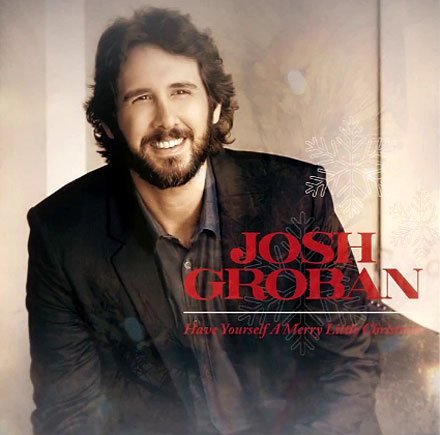
Copyright Reprise / Warner Bros. All rights reserved
Mind you, this isn’t the only time in recent memory that this holiday song has charted. Back in 2014, Sam Smith’s cover of “Merry Little Christmas” made it into Billboard’s Hot 100 . And Michael Bublé’s version did equally well back in 2011.
Which is pretty impressive. Especially when you take into consideration that – in spite of its rather ironic title — “Have Yourself a Merry Little Christmas” is actually one of the saddest holiday songs ever written.
Mind you, it used to be even sadder. When Martin & Blane originally wrote this tune for MGM’s 1944 musical, “Meet Me in St. Louis,” it was supposed to musically comment on that moment in this motion picture where the Smith family had just learned that – due to Father’s promotion – they’d now all have to move to New York and thus miss out on seeing the 1904 World’s Fair.
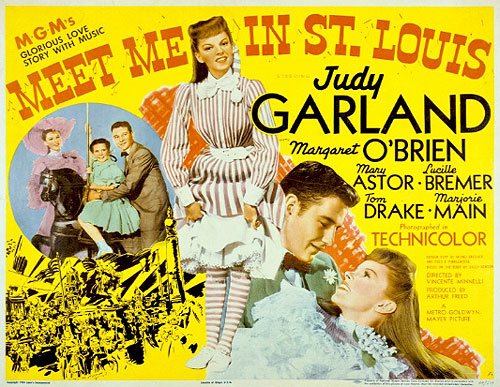
Copyright Warner Bros. Entertainment. All rights reserved
So – as older sibling Esther (played by Judy Garland ) attempted to console her heart-broken little sister Tootie (played by Margaret O’Brien ) during a scene set on Christmas Eve, Ralph & Hugh had originally envisioned “Have Yourself a Merry Little Christmas” getting underway by having Garland’s character sing:
Have yourself a merry little Christmas
It may be your last
Next year we may all be living in the past
Have yourself a merry little Christmas
Pop that champagne cork
Next year we may all be living in New York.
Judy balked at singing these lyrics as written, arguing that – if her character actually said something like that to her little sister – Esther would wind up traumatizing poor Tootie. Which would then make the audience hate her character. And when “Meet Me in St. Louis” director Vincente Minnelli (who would go on to marry Garland the following year) backed up his star, Martin & Blane were forced to soften this song’s opening stanza.

Copyright Warner Bros. Entertainment. All rights reserved
Have yourself a merry little Christmas
Let your heart be light
Next year all our troubles will be out of sight
Have yourself a merry little Christmas
Make the yuletide gay
Next year all our troubles will be miles away
When MGM released “Meet Me in St. Louis” to theaters in November of 1944, it was a smash hit for the studio. And Garland’s version of “Have Yourself a Merry Little Christmas” proved to be so popular during the waning days of World War II that Decca actually released two different versions of this recording over a 6-month period. One paired this holiday tune with another Martin & Blane song from “Meet Me in St. Louis,” “The Boy Next Door.” This version was then followed up by a Decca recording that paired “Have Yourself a Merry Little Christmas” with Garland’s performance of “You’re Never Walk Alone.” This Rodgers & Hammerstein song had quickly become a favorite after it was introduced in “Carousel,” which opened on Broadway back on April 19, 1945.
Barring some relatively minor tweaks to the song’s lyrics (i.e., “From now on” replacing the phrase “Next year”), this was the version of “Have Yourself a Merry Little Christmas” that was performed from 1944 – 1957.
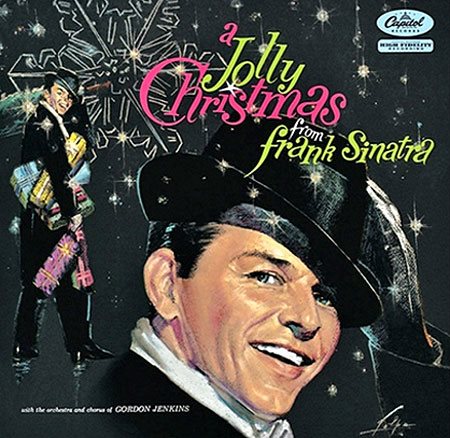
Copyright Capitol Records, Inc. All rights reserved
“So what happened in 1957?,” you ask. Well, Old Blue Eyes went into the studio at Capital Records to record his very first full-length Christmas album, “A Jolly Christmas from Frank Sinatra.” Frank labored from May 1 st through July 10, 1957 on this recording. Working in front of an orchestra conducted by Gordon Jenkins and backed up by the Ralph Brewster Singers, he put that distinctive Sinatra spin on such holiday favorites as “Jingle Bells,” “Silent Night,” and “I’ll be Home for Christmas.”
But when it finally came time to record Frank’s version of ‘Have Yourself a Merry Christmas,” Old Blue Eyes balked. Largely because Sinatra felt that the closing stanza of this song (as it was originally written for “Meet Me in St. Louis”) …
Someday soon we all will be together
If the fates allow
Until then, we’ll have to muddle through somehow
So have yourself a merry little Christmas now
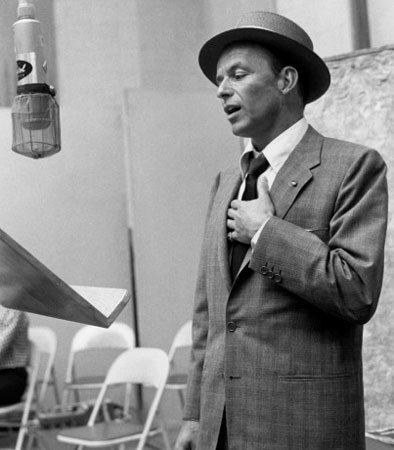
Frank Sinatra recording at Capital Studios in Hollywood in the 1950s
… was far too bleak.
So Frank reached out to Hugh Martin and supposedly said that ” … I’m working on an album called ‘A Jolly Christmas.’ I’d really like to include ‘Merry Little Christmas’ on this recording, but that ‘ … muddle through’ line is a real downer. Do you think you could jolly up that line for me?”
And given that it was now the more hopeful 1950s … Well, Hugh agreed to tweak “Merry Little Christmas” ‘s lyrics for Frank. Swapping out ” … until then, we’ll have to muddle through somehow” for ” … hang a shining star upon the highest bough.” Which then allowed this still-bittersweet holiday song to end on a more upbeat note.
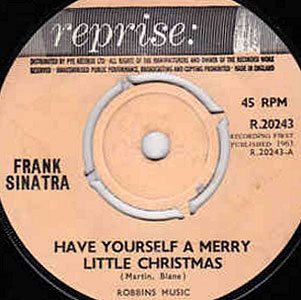
Copyright Reprise / Warner Bros. All rights reserved
And since the Sinatra version of “Have Yourself a Merry Little Christmas” became a smash hit … For nearly 50 years now, singers have had to make a hard choice whenever they decide to perform this holiday standard. Do they do as Judy did back in “Meet Me in St. Louis” and opt to ” … muddle through” what can often be a very emotional time of year? Or do they follow Frank’s example and offer a more hopeful view of the season? Literally reaching for the stars by hanging one ” … upon the highest bough” ?
Me? I have to admit that I’m one of those guys who embraces what Walt Disney once supposedly said (i.e.,”For every laugh, there should be a tear”). So I honestly don’t mind a little melancholy mixed in with my Merry Christmas. Which is why it kind of does my heart good to hear versions of “Have Yourself a Merry Little Christmas” like the one James Taylor performs. Where the original bittersweet message of this Martin & Blane song is basically left intact.
But how about you folks? When you’re having “A Merry Little Christmas,” which version of this holiday classic do you prefer? Are you a muddler like myself? Or do you prefer to hang a shiny star?
This article was originally published by the Huffington Post on Saturday, December 24, 2016
Music
Seth MacFarlane celebrates the classic Christmas albums of the 1940s & 1950s with “Holiday for Swing!”

So how much time does it take to craft a brand-new holiday
album that has a timeless sound?
To hear Joel McNeely (i.e., the Emmy Award-winning arranger
/ producer behind Seth MacFarlane
's " Holiday for
Swing!
") talk, it took a full year to lay down all 13 tracks for this
top-selling recording. Which honors the rich sound / orchestral jazz tradition of
those classic Christmas albums that Bing Crosby, Perry Como and Rosemary
Clooney performed on back in the 1940s & 1950s.
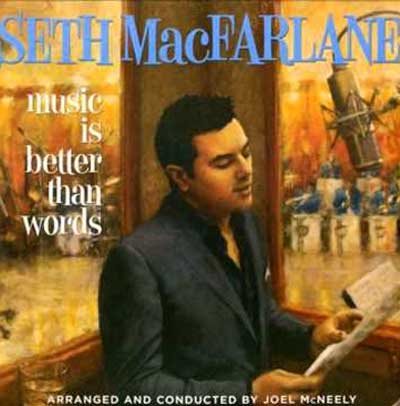 Copyright 2011 Universal Republic. All rights reserved
Copyright 2011 Universal Republic. All rights reserved
"What with his film work and all the TV series he rides herd on, Seth's schedule is just crazy these days. But he and I had such a good time working together on ' Music is Better than Words ' that Seth were determined to carve out time necessary to record a second album," Joel explained during a recent phone interview. "Ironically it wasn't until 2012 when the two of us were over in England doing promo for that first album when the two of us realized that we both had the exact same weekend free. And since I already had six arrangements done for the holiday album that we had been talking about doing, Seth and I decided to get started recording. Which is when I made a quick call to Abbey Road."
Thankfully because of all the film work that he'd previously done at Abbey Road Studios , McNeely was able to pull in a few favors and book some time in Studio Two. And once he'd secured use of what many people consider the most famous recording studio in the world ("This is where the Beatles recorded," Joel enthused. "Which is why — if you're someone who works in the music field — you almost feel like you have to genuflect when you enter this space. I mean, the tinny piano that they used is still sitting there in the corner. You can walk right up and play it!"), he then reached out to some of London's best musicians.
"We even brought over Peter Erskine
, the great jazz
drummer. Mind you, Studio Two is not a huge room. But we eventually wedged 54
players in there. But not a one of those musicians was off in an iso booth.
Everybody was in the same space. We had Peter and his drums right in the center
of the orchestra amongst all the strings and the woodwinds. So his sound was
leaking into all the other mics. And everybody else's sound was leaking into
everybody else's mics," McNeely said.
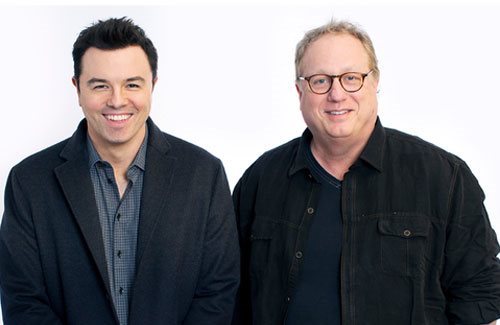 Seth MacFarlane and Joel McNeely
Seth MacFarlane and Joel McNeely
"And why was that important?," you ask. Because Seth and Joel were out to replicate a very particular sound from that era of recording. You see, when everyone's in the exact same space at the exact same time working on a track for an album, you get less of a pristine sound. And as a direct result, whatever you're recording then sounds more like a live performance.
"And given that all those classic holiday albums that
Ray Conniff and Dean Martin and Frank Sinatra did back in the day all have that
same sort of sound and feel … Well, Seth and I wanted this record to sound
like it had been part of that era as well. That 'Holiday
for Swing!' come across as this honest, completely sincere and authentic celebration
of all those great orchestral Christmas songs that were produced back in the
1940s and 1950s," McNeely stated.
So how did Seth & Joel go about choosing the holiday
songs that would be featured on this recording? Given that MacFarlane has an
almost encyclopedic knowledge of the great American songbook, McNeely opted to
let Seth choose the line-up for "Holiday for
Swing!"
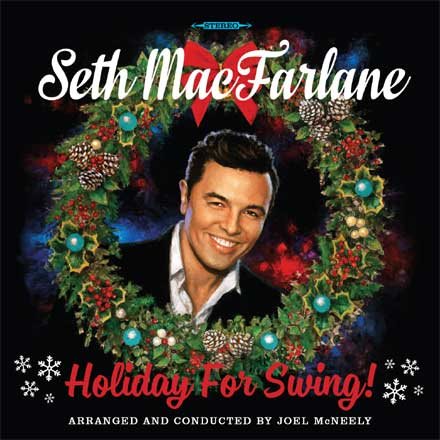 Copyright 2014 Universal Republic. All rights reserved
Copyright 2014 Universal Republic. All rights reserved
"Seth knows more obscure songs than anyone I've ever
worked with. On 'Music is Better than Words,' he just pulled all of these great
songs that I'd never heard of right out of his hat. Seth genuinely delights in
unearthing musical numbers that very few people have ever heard of before,"
Joel stated. "So that was what he wanted to do with this holiday album. Split 'Holiday
for Swing!' between those classic Christmas numbers that everyone knows and
those holiday songs that maybe you haven't heard before like 'Christmas
Dreaming' and 'Little Jack Frost Get Lost."
And what was Joel's job on this project? To come up withorchestrations that he hoped would then make Seth laugh.
"Look, when you're working with a comedy professional,
you generally keep your jokes to yourself.
Because there's just no way that you can ever come with a gag that this
guy hasn't heard before or doesn't already know," McNeely explained.
"But what I can do — by making the orchestrations for these holiday songs
as fun as possible — is make Seth laugh with music. Try and tell a story with
each arrangement. Take — for example — 'Mele Kalikimaka.' The way that I orchestrated
this song for 'Holiday for Swing!,' it supposed to sound
like something straight out of a Bob Hope / Bing
Crosby Road picture. A moment from one of those movies where they enter
a jungle clearing and find this crazy witch doctor getting ready for Christmas.
That's just the sort of arrangement that I knew would make Seth laugh. And it
did."
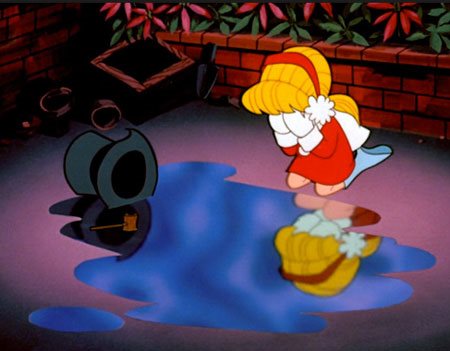 Copyright Classic Media, LLC. All rights reserved
Copyright Classic Media, LLC. All rights reserved
Mind you, not every witty reinvention of a holiday classic that
Joel dreamed up for "Holiday for Swing!" madethe final cut. Take — for example — Joel's bluesy take on "Frosty the
Snowman."
"When everyone else does 'Frosty,' they treat it as
this upbeat, bouncy tune. But if you actually listen to the lyrics, you then
realize that 'Frosty' is this really sad holiday song. I mean, he dies, the snowman
melts at the end of this song. So I thought that it might be fun to embrace the
sad story that those lyrics are actually trying to tell people. Turn 'Frosty
the Snowman' into this really dark, kind of bluesy dirge. But every which way I
went with that arrangement, it just felt false. I still believe in this
concept. I think that there's a genuinely funny take on this holiday classic in
there somewhere. But in the end, what Seth and I were looking to do with 'Holiday
for Swing!' was create a sincere, authentic Christmas album. Make something
that celebrated these songs, not do something that was mean-spirited or riffed
on these holiday classics. Which is why 'Frosty' never made it past the this-sounds-like-a-funny-idea
stage," McNeely said.
And once those first six holiday songs were laid down, what
with working on "Ted," "Family Guy," "American
Dad," "A Million Ways to Die in the West" and
"Cosmos," it would be another full year before Seth & Joel could
get then together again and record the last seven tracks for "Holiday for
Swing!"
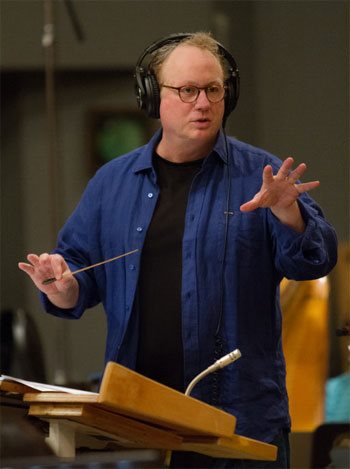 Arranger / composer Joel McNeely
Arranger / composer Joel McNeely
"And 'The Christmas Song' at the very end of this
album, that was just a Hail Mary. We were done recording and there was this
beautiful grand piano there in the recording studio. And I said 'Hey, you wanna
do this?' So we quickly up a mic and then did 'A Christmas Song' two times
straight through. And the second take is what you can now hear in its entirety
on the album. It was recorded live just with that piano. A simple and sincere
version of that song," McNeely recalled. "Which — to be honest — was
kind of the effect that I was going for. That — after all of the wackiness and
merriment that had preceded 'The Christmas Song' on 'Holiday
for Swing!' — I thought that it might be smart to put something quiet and
reflective at the end at this recording."
Well, clearly Christmas shoppers have approved of what Seth
& Joel put together. Given that — for a time — "Holiday
for Swing!" was the No. 1 recording for 2014. Just last week, this Universal
Republic recording occupied the
Number 8 position on Billboard's Holiday Album chart.
"Look, the fact that this album has been selling well is great
news. But from Seth's point of view, what really matters most is that the stuff
he loves — orchestral jazz — is getting out there again and being heard and
that people seem to be enjoying it," Joel stated. "I mean, you have
to understand that Seth doesn't take vacations. The way that he blows off steam
is by doing something he really loves. Which is singing. So when we were doing
promo for 'Holiday for Swing!' earlier this month and — in the span of one day
— Seth had to sing live on 'Good Morning America,' 'Live with Kelli and
Michael,' 'The View' and then finish that trip to NYC by performing on NBC's 'Lighting-of-the-Rockefeller-Center-Christmas-Tree'
TV program … I've honestly never seen the guy happier. These music projects
are just like candy to him."
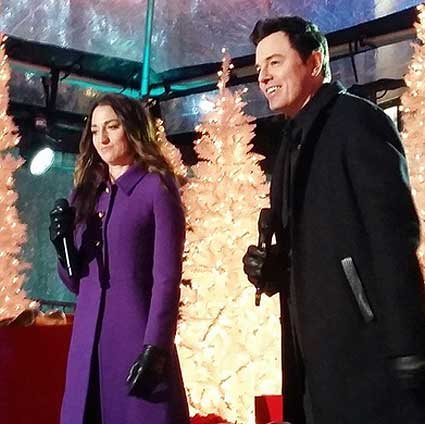 Sara Bareilles and Seth MacFarlane perform "Baby, It's Cold Outside" at
Sara Bareilles and Seth MacFarlane perform "Baby, It's Cold Outside" at
the 82nd Rockefeller Center Christmas Tree Lighting ceremony.
Copyright National Broadcasting Company. All rights reserved
Which perhaps explains why MacFarlane is already texting McNeely with ideas
and concepts for yet another album. One that Joel is really not free to talk
about at this point, but — should it ever actually come to pass (which, given
Seth's extremely packed schedule, is a very legitimate concern) — it could
possibly top the fun of "Music is Better than Words" and "Holiday
for Swing!"
FYI: If you'd like to see MacFarlane perform live, he'll be
singing on New Year's Eve with the San Francisco Symphony
. Where — I'll bet
you — Seth will be performing Joel's arrangement of that Frank Loesser holiday
favorite, "What Are You Doing New Year's Eve?"
This article originally appeared on the Huffington Post's Entertainment page on December 24, 2014
Music
Sing Along with Mickey and Oswald in Epic Mickey 2: The Power of 2
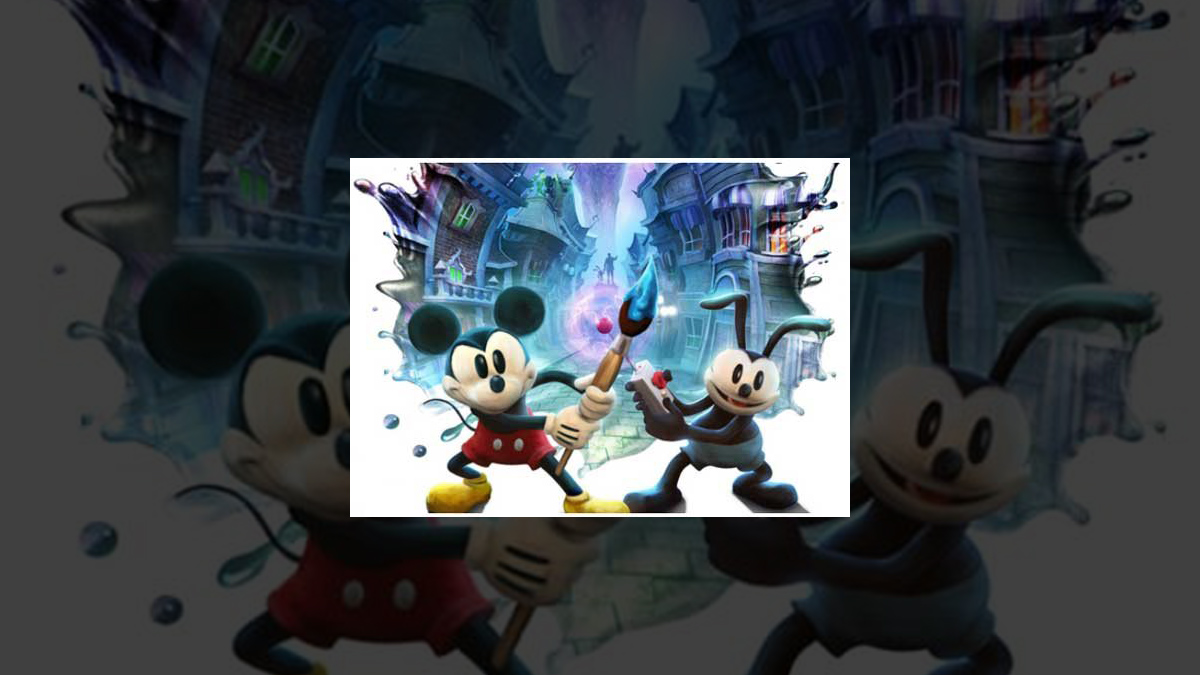
Disney
Interactive Media Group
and game designer, master storyteller and huge Disney
geek Warren Spector announced the sequel to last year's Wii game " Disney Epic Mickey
,"
with some changes that fans will love – or hate. The problems with the camera that plagued
Epic Mickey will be a thing of the past, and Oswald will be a playable,
speaking character.
Traditionalists
may argue that since Oswald never had a voice in his Disney shorts, he shouldn't
talk now. However, the majority of gamers who play the Epic Mickey games won't
know this, and might find a silent character off-putting. He DID
speak in Epic
Mickey, but the sounds that emanated from the characters were more like sighs
and grunts, something Warren Spector stated
(in Nintendo Power Magazine
) was
akin to the classic Mario games
.
 Copyright Disney Enterprises, Inc. All rights reserved
Copyright Disney Enterprises, Inc. All rights reserved
Not
only will the characters speak in Epic Mickey 2: The Power of Two
, they will sing!
Epic Mickey 2: The Power of Two will be a
classic Disney magical, musical adventure, with songs written especially for
the game by James Dooley
(" Pirates Of The Caribbean: The Curse Of The Black Pearl
/ At World's End
," " The Simpsons Movie
") and Mike Himelstein (" Shrek
," " Mickey Mouse Clubhouse
") – note: Himelstein wrote the hilarious " Welcome to Duloc
."
Oswald
will not only be a playable character for co-operative play (two people playing
together) but will also be a strong NPC (non-player character), with intuitive
AI (artificial intelligence). What do all these acronyms mean? It means that
even if you're playing alone as Mickey, Oswald will join you independently and
actually help you get along as the game progresses. This is a wonderful and
rare thing in the gaming world.
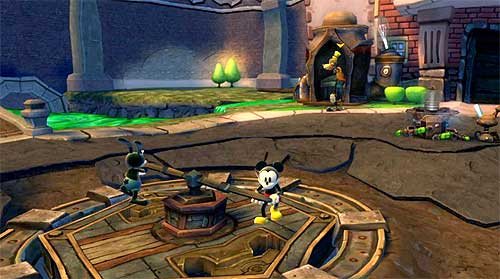 Copyright Disney Enterprises, Inc. All rights reserved
Copyright Disney Enterprises, Inc. All rights reserved
PlayStyle
Matters, which was explored a bit in the first game, will be further exploited
in the sequel. PSM means that the decisions you make as a player toward "good"
or "scrappy Mickey are actually reflected in later gameplay, Mickey with his
paint/thinner brush like in the first game, Oswald with a remote control that
controls electricity. In Epic Mickey,
Mickey actually changed his looks depending upon whether the player played him
as kind or not.
Disney Epic Mickey 2: The Power of Two
will be the first cross-platform Epic Mickey game,
playable not only on the Nintendo Wii
but also on the Xbox 360
and the PlayStation 3
, introducing the story and characters to a much wider audience of
gamers.


























